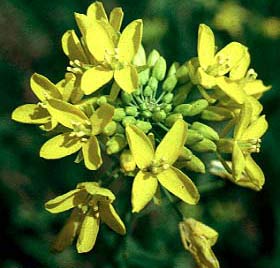Greenhouse effect causes plants to flower early
Some shrubs have the ability to shorten flowering time to adapt to climate warming. This is the first signal of an " evolutionary explosion " caused by the greenhouse effect.
Shrubs can adapt more quickly to climate change because they have a short life cycle, said Arthur Weis, a professor of biology at the University of California. But some species of perennials - such as conifer and cypress in California (USA) with a life cycle of several hundred years - will not be able to keep up with changes in the environment because their life cycles are too long.

Brassica campestris (Photo: gresham)
Weis said some shrubs, including Brassica campestris (a mustard plant), have shortened flowering time after exactly 7 years.
He and his colleagues planted two seeds of Brassica campestris in a greenhouse. The first batch was harvested in 1997, just before the five-year drought in California. The second batch was harvested in 2004, shortly after the drought ended.
When seeds germinate, they are divided into three groups, each of which is cared for differently. In all cases, groups of plants germinate from seeds that are born after drought to flower very early, meaning they can form seeds before the soil becomes arid. The group of plants germinates from seeds that are born before drought to flower later.
On the timeline of evolution, how is this rate of change calculated? Weis estimates that the adaptive speed of Brassica campestris is 16% in 7 generations.
"It was a dizzying speed , " he said. "To make it easier to imagine, we just need to imagine that, if humans evolve at the same rate as mustard plants in our tests, our average reproductive age will decrease from 16 to 13.5 in 7 generations ".
Weis' group is working on a project to store, dry and freeze seeds of hundreds of plants in North America so they can be studied for 50 years from now. They claim that climate warming will create many evolutionary changes in plants and scientists will need evidence of them at the time the changes take place.
Viet Linh
- The greenhouse effect slows down due to atmospheric pollution
- Plants flee climate change
- Trees grow fast thanks to the greenhouse effect
- The greenhouse effect can prevent life from living outside of Earth
- Greenhouse effect
- 10 most exotic effects of the greenhouse effect
- 10 most rare and beautiful flowers in the world
- Cows also cause a greenhouse effect
- More than 300 million people are suffering from greenhouse gases
- Bustling 'Tet flowers' in the Capital
- Effects and harms of milk flowers
- Greenhouse effect 'push' many animals up high
 Why do potatoes have eyes?
Why do potatoes have eyes? 'Tragedy' the world's largest carnivorous life: Death becomes ... public toilet
'Tragedy' the world's largest carnivorous life: Death becomes ... public toilet Tomatoes were once considered 'poisonous' for 200 years
Tomatoes were once considered 'poisonous' for 200 years Detecting microscopic parasites on human face
Detecting microscopic parasites on human face